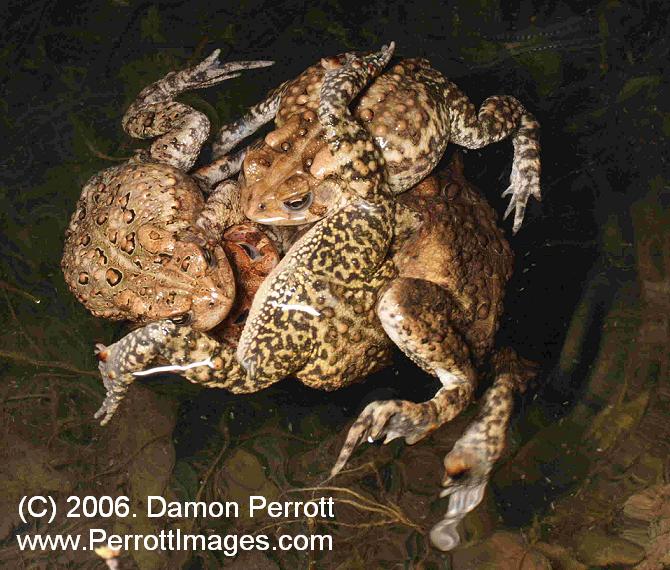Two Primary Modes of Anuran Reproduction
Kentwood D. Wells landmark work, Social-Behavior Of Anuran Amphibians (1979), divided anuran reproduction into two major breeding systems: explosive and prolonged. Both explosive and prolonged species are found in each anuran family. However, some families' species are more inclined to be one or the other. Toads are generally explosive breeders. Treefrogs, family Hylidae, are generally prolonged breeders.
Explosive breeding is common to many toads, family Bufonidae. After warm spring rains, large congregations of toads assemble and begin a frantic competition for mates. Males greatly outnumber their female counterparts and competition for females is fierce. Males actively search for mates and engage in bouts of wrestling. Some males try to mate with each other or even inanimate objects. Neither males or females do much calling. When a male accidentally tries to mate with another male, the surprised mate will occasionally give a release call. Males often find and amplex a female only to be knocked off by other males. This displacement gives larger, stronger males a significant mating advantage. Such males also tend to be older. Smaller, younger males, may go an entire season without reproducing successfully. Females, which have a high likelihood of successfully mating if they even enter the breeding grounds, only come to mate once or twice a year. This also explains the imbalance in male and female numbers.
This figure shows a scramble competition between several explosive breeding American toads (Bufo americanus).
The primary feature of the prolonged breeding is female choice. Males often sit from staked-out territories and use advertisement calls to attract females. Females hop around the chorus, listening to the various males and ultimately make a decision. The calls males emit generally confer some information about the male’s physical characteristics. A low frequency is correlated with a large male and a loud, intense call is correlated with an energetic male. Females can use this information along with territorial quality to find the best available mate.
These types of breeding systems can be applied to most species of frogs. However, some species exhibit bizarre mating behaviors that do not seem to fit these categories. These are generally tropical species with environments that differ significantly from a temperate environment. Some species appear to shift between the two modes, depending on environmental factors.






 Go to quick links
Go to quick search
Go to navigation for this section of the ToL site
Go to detailed links for the ToL site
Go to quick links
Go to quick search
Go to navigation for this section of the ToL site
Go to detailed links for the ToL site